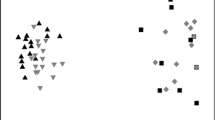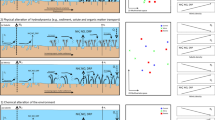Abstract
In coastal wetlands, invasive plants often act as ecosystem engineers altering flow, light and sediments which, in turn, can affect benthic animal communities. However, the degree of influence of the engineer will vary significantly as it grows, matures and senesces, and surprisingly little is known about how the influence of an ecosystem engineer varies with ontogeny. We address this issue on the tidal flats of San Francisco Bay where hybrid Spartina (foliosa × alterniflora) invaded 30 years ago. The invasion has altered the physico-chemical properties of the sediment habitat, which we predicted should cause changes in macrofaunal community structure and function. Through mensurative and manipulative approaches we investigated the influence of different growth stages of hybrid Spartina on macrobenthos and the underlying mechanisms. Cross-elevation sampling transects were established covering 5 zones (or stages) of the invasion, running from the tidal flat (pre-invasion) to an unvegetated dieback zone. Additionally, we experimentally removed aboveground plant structure in the mature (inner) marsh to mimic the ’unvegetated areas’. Our results revealed four distinct faunal assemblages, which reflected Spartina-induced changes in the corresponding habitat properties along an elevation gradient: a pre-invaded tidal flat, a leading edge of immature invasion, a center of mature invasion, and a senescing dieback area. These stages of hybrid Spartina invasion were accompanied by a substantial reduction in macrofaunal species richness and an increase in dominance, as well as a strong shift in feeding modes, from surface microalgal feeders to subsurface detritus/Spartina feeders (mainly tubificid oligochaetes and capitellid polychaetes). Knowledge of the varying influence of plant invaders on the sediment ecosystem during different phases of invasion is critical for management of coastal wetlands.







Similar content being viewed by others
References
Ayres DR, Strong DR, Baye P (2003) Spartina foliosa (Poaceae) – A common species on the road to rarity. Madroño 50:209–213
Berg P, McGlathery KJ (2001) A high-resolution pore water sampler for sandy sediments. Limnol Oceanogr 46:203–210
Bruno J, Bertness MD (2001) Positive interactions, facilitations and foundation species. In: Bertness MD, Gaines SD, Hay M (eds) Marine community ecology. Sinauer Associates, Inc Publishers, Sunderland, Massachusetts, pp 201–218
Brusati E, Grosholz ED (2006) Native and introduced ecosystem engineers produce contrasting effects on estuarine infaunal communities. Biol Invas 8:683–695
Chapin III FS, walker LR, fastie CL, Sharman LC (1994) Mechanisms of primary succession following deglatiation at Glacier Bay, Alaska. Ecol Monogr 64:149–175
Clarke KR, Warwick RM (2001) Change in marine communities: an approach to statistical analysis and interpretation, 2nd edition. PRIMER-E, Plymouth
Cline JD (1969) Spectrophotometric determination of hydrogen sulfide in natural waters. Limnol Oceanogr 14:454–458
Crews TE, Kitayama K, Fownes JH, Riley RH, Herbert DA, Mueller-Dombois D, Vitousek PM (1995) Changes in soil phosphorous fractions and ecosystem dynamics across a long chronosequence in Hawaii. Ecology 76:1407–1424
Crooks JA (2002) Characterizing ecosystem-level consequences of biological invasions: the role of ecosystem engineers. Oikos 97:153–166
Daehler CC, Strong DR (1996) Status, prediction and prevention of introduced cordgrass Spartina spp. invasions in Pacific estuaries, USA. Biol Conserv 78:51–58
Georgia Coastal Research Council (GCRC) (2004) Available online: http://www.marsci.uga.edu/coastalcouncil/
Gray AJ, Marshall DF, Raybould AF (1991) A century of evolution in Spartina anglica. Adv Ecol Res 21:1–62
Grosholz ED, Levin LA, Tyler AC, Neira C (in press) Changes in community structure and ecosystem function following Spartina alterniflora invasion of Pacific estuaries. In: Silliman BR, Bertness MD, Grosholz ED (eds) Anthropogenic Modification of North American Salt Marshes. University of California Press, Berkeley, CA
Harkantra SN, Rodrigues NR (2003) Pattern of species succession of soft-bottom macrofauna in the estuaries of Goa, west coast of India. Current Sci 85:1458–1464
Hartig EK, Gornitz V, Kolker A, Mushacke F, Fallon D (2002) Anthropogenic and climate-change impacts on salt marshes of Jamaica Bay, New York City. Wetlands 22:71–89
Hedge P, Kriwoken LK (2000) Evidence for effects of Spartina anglica invasion on benthic macrofauna in Little Swanport estuary, Tasmania. Austral Ecol 25:150–159
Jackson D (1985) Invertebrate populations associated with Spartina anglica salt-marsh and adjacent intertidal mud flats. Estuar Brackishwater Sci Assoc Bull 40:8–14
Jones CG, Lawton JH, Shachak M (1994) Organisms as ecosystem engineers. Oikos 689:373–386
Lee RW, Kraus DW, Doeller JE (1999) Oxidation of sulfide by Spartina alterniflora roots. Limnol Oceanogr 44:1155–1159
Levin LA, Talley TS, Hewitt J (1998) Macrobenthos of Spartina foliosa (Pacific Cordgrass) salt marshes in southern California: community structure and comparison to a Pacific mudflat and a Spartina alterniflora (Atlantic Smooth Cordgrass) marsh. Estuaries 21:120–144
Levin LA, Neira C, Grosholz ED (2006) Invasive cordgrass modifies wetland trophic function. Ecology 87:419–432
Linthurst RA, Seneca ED (1980) Dieback of salt-water cordgrass (Spartina alterniflora Loisel.) in the lower Cape Fear estuary of North Carolina: an experimental approach to re-establishment. Environ Conserv 7:59–66
McAleece N, Lambghead PJD, Paterson GLJ, Gage JD (1999) Biodiversity Pro. Freeware at http://www.nrmc.demon.co.uk/bdpro/
McCann LD, Levin LA (1989) Oligochaete influence on settlement, growth and reproduction in a surface-deposit-feeding polychaete. J Exp Mar Biol Ecol 131:233–253
McKee KL, Mendelssohn IA, Materne MD (2004) Acute salt marsh dieback in the Mississippi River deltaic plain: a drought-induced phenomenon? Global Ecol Biogeogr 13:65–73
Meyer-Reil LA (1983) Benthic response to sedimentation events during autumn to spring at a shallow water station in the Western Kiel Bight. II. Analysis of benthic bacterial populations. Mar Biol 77:247–256
Neira C, Levin LA, Grosholz ED (2005) Benthic macrofaunal communities of three sites in San Francisco Bay invaded by hybrid Spartina, with comparison to uninvaded habitats. Mar Ecol Prog Ser 292:111–126
Neira C, Grosholz ED, Levin LA, Blake R (2006) Mechanisms generating modification of benthos following tidal flat invasion by a Spartina hybrid. Ecol Appl 16:1391–1404
Netto SA, Lana PC (1999) The role of above- and below-ground components of Spartina alterniflora (Loisel) and detritus biomass in structuring macrobenthic associations of Paranaguá Bay (SE, Brazil). Hydrobiologia 400:167–177
O’Connell KA (2002) Effects of invasive Atlantic smooth-cordgrass (Spartina alterniflora) on infaunal macroinvertebrate communities in southern Willapa Bay, WA. Ms thesis, Western Washington University
Pennings SC, Bertness MD (2001) Salt marsh communities. In: Bertness MD, Gaines SD, Hay ME (eds) Marine community ecology. Sinauer Associates, Inc Publishers, Sunderland, Massachusetts, pp 289–316
Pearson TH, Rosenberg R (1978) Macrobenthic succession in relation to organic enrichment and pollution of the marine environment. Oceanogr Mar Biol Ann Rev 16:229–311
Reed DJ (1992) Effects of weirs on sediment deposition in Louisiana coastal marshes. Environ Manage 16:55–65
Rhoads DC, Boyer LF (1982) The effects of marine benthos on physical properties of sediments: a successional perspective. In: McCall PL, Tevesz MJS (eds) Animal-sediment relations. Plenum Press, New York, pp 3–52
Silliman BR, Bertness MD (2002) A trophic cascade regulates salt marsh primary production. Proc Nat Acad Sci 99:10500–10505
Silliman BR, van de Koppel J, Bertness BD, Stanton LE, Mendelssohn IA (2005) Drought, snails, and large-scale die-off of southern US salt marshes. Science 310:1803–1806
Steenkamp HE, Chown SL (1996) Influence of dense stands of an exotic tree, Prosopis glandulosa Benson, on a savanna dung bettle (Coleoptera: Scarabaeinae) assemblage in southern Africa. Biol Conserv 78:305–311
Talley TS, Levin LA (2001) Modification of sediments and macrofauna by an invasive marsh plant. Biol Invasions 3:51–68
van de Koppel J, van der Wahl D, Bakker JP, Herman MJ (2005) Self-organization and vegetation collapse in salt marsh ecosystems. Am Nat 165:E1–E12
Vivrette NJ, Muller CH (1977) Mechanism of invasion and dominance of coastal grassland by Mesembryanthemum crystallinum. Ecol Monogr 47:301–318
Vitousek PM, Walker LR, Whiteaker LD, Mueller-Dombois D, Matson PA (1987) Biological invasion by Myrica faya alters ecosystem development in Hawaii. Science 238:802–804
Wardle DA, Ghani A (1995) A critique of the microbial metabolic quotient (qCO2) as a bioindicator of disturbance and ecosystem development. Soil Boil Biochem 27:1601–1610
Webb EC, Mendelssohn LA, Wilsey BJ (1995) Causes for vegetation dieback in a Louisiana salt marsh: a bioassay approach. Aquatic Bot 51:281–289
Zajac RN, Robert RB, Whitlatch RB (1982) Response of estuarine infauna to disturbance. II. Spatial and temporal variation of succession. Mar Ecol Prog Ser 10:15–27
Zipperer VT (1996) Ecological effects of the introduced cordgrass, Spartina alterniflora, on the benthic community structure of Willapa Bay, Washington. Ms Thesis, University of Washington, Seattle, Washington
Acknowledgements
We would like to thank R. Blake, C. Tyler, U. Mahl, C. Whitcraft, N. Christiansen, C. Love, N. Rayl, E. Brusati, P. McMillan, and J. Gonzalez for assistance in the field and in the laboratory. We gratefully acknowledge S. Maezumi for her dedication and thorough sorting of invertebrates. We are grateful to C. Janousek who kindly assisted with HPLC pigment analyses, and M. Vernet for providing HPLC facilities. We acknowledged Steve Fend (US Geological Survey) for identification of Monopylephorus evertus. We thank C. Nordby, R. Blake, and E. Brusati for providing compliance with California Clapper Rail permit requirements. We thank C. Whitcraft and A. Demopoulus for comments and literature suggestions. Comments by two anonymous reviewers are highly appreciated. Support was provided by the National Science Foundation Biocomplexity Program (DEB 0083583) to L.A.L and E.D.G.
Author information
Authors and Affiliations
Corresponding author
Appendices
Rights and permissions
About this article
Cite this article
Neira, C., Levin, L.A., Grosholz, E.D. et al. Influence of invasive Spartina growth stages on associated macrofaunal communities. Biol Invasions 9, 975–993 (2007). https://doi.org/10.1007/s10530-007-9097-x
Received:
Accepted:
Published:
Issue Date:
DOI: https://doi.org/10.1007/s10530-007-9097-x




